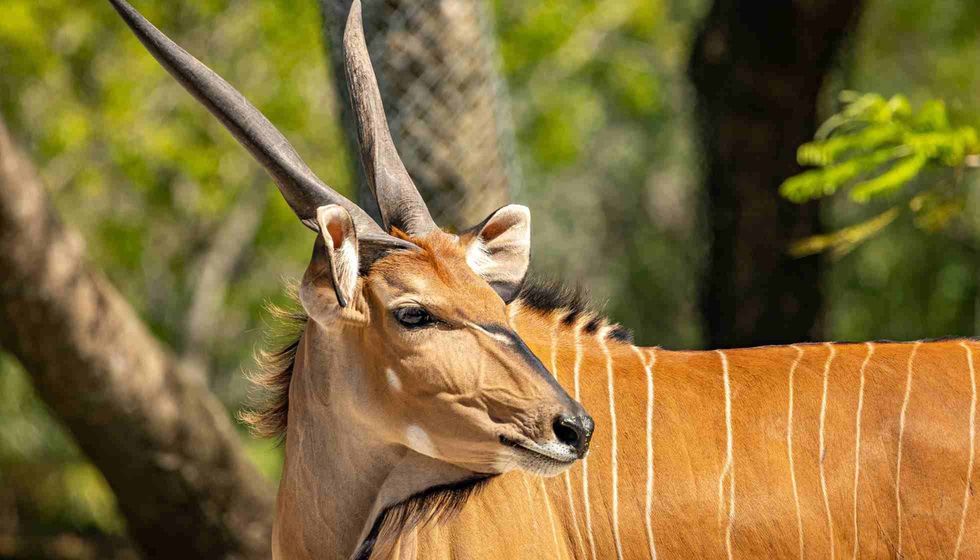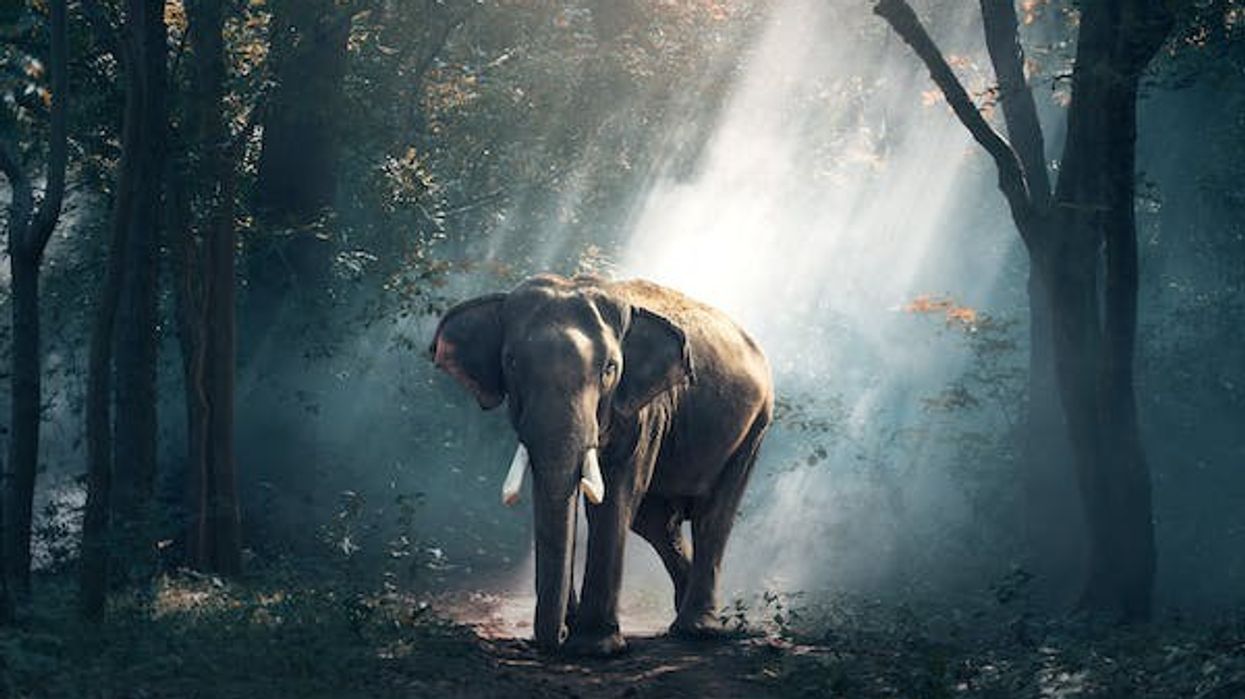The giant eland (Taurotragus derbianus), otherwise called the Lord Derby eland, is an open-timberland and savanna species of antelope. The giant eland is the largest antelope species in the world and it has two subspecies.
These are the eastern giant eland ( Taurotragus derbianus gigas) and the western giant eland (Taurotragus derbianus gigas). The giant eland is a herbivore whose diet consists of grasses, foliage, and branches. They generally live in little herds comprising 15–25 elands, both males and females.
Giant elands are not territorial and have huge home ranges. Their sexual mating takes place consistently throughout the year, particularly in the wet season.
Here, we have many amazing and interesting facts about the giant eland that you will enjoy. Learn more about this species of savanna antelope that is named in honor of Edward Smith-Stanley, who is the 13th Earl of Derby.
Let's take a look at these facts and information, and if you enjoy these then, do read our royal antelope and giant sable antelope facts.
Giant Eland Interesting Facts
What type of animal is a giant eland?
A giant eland (Taurotragus derbianu) is a species of savanna antelope that is native to the African subcontinent. They are most commonly found in the grasslands of eastern and southern Africa, Western Africa, Chad, and Guinea.
What class of animal does a giant eland belong to?
A giant eland (Taurotragus derbianus) belongs to the class of mammals.
How many giant elands are there in the world?
As per the IUCN Red List, there are only 12000-14000 giant elands in the world, and their population is continually decreasing.
Where does a giant eland live?
The giant eland (Taurotragus derbianus) is an open forest animal and therefore prefers to live in open grasslands, woodlands, broad-leafed savanna, forests, and deserts.
What is a giant eland's habitat?
The habitat of a giant eland (Taurotragus derbianus) is mainly found along the African subcontinent comprising eastern, western, and central Africa, Chad, Senegal, Cameroon, and the Democratic Republic of Congo.
Who do giant elands live with?
Giant elands are social animals and form separate herds of males, females, and calves. Giant eland herds mostly comprise 15-25 animals that do not disband even in the wet season. However, adult males usually stay solitary and spend time with females lasting for an hour to a week.
How long does a giant eland live?
Giant eland antelope have a lifespan range between 20-25 years.
How do they reproduce?
Being polygynous in nature, the dominant males mate with multiple females, and the males' fight with their horns for dominance during the breeding season. Males lock horns during these fights and try to twist their opponents' necks to win.
This is accompanied with the rubbing of foreheads in mud or fresh urine by the males and throwing and threshing of loose earth on their body using their horns.
The mating of giant elands lasts throughout the year, and it peaks during the wet season.
The female gestation period lasts nine months, after which she delivers a single calf that remains with its mother for six months or more and feeds on her milk. Females usually reach sexual maturity at two years, whereas the male reaches sexual maturity at four to five years.
What is their conservation status?
The conservation status of the giant eland, also known as the giant eland bull, is not endangered but is Vulnerable as per the IUCN Red List, whereas the conservation status of western giant eland is Critically Endangered.
Their population is continually decreasing because they are killed for hunting and eating purposes as giant eland meat is considered very healthy and tasty.
As of now, the western giant eland is found only in the Niokolo-Koba National Park of Senegal, and it is considered Critically Endangered.
Giant Eland Fun Facts
What do giant elands look like?
Giant eland animals are open forest antelopes whose color range from a smooth reddish-brown to chestnut coat with 8-12 defined vertical white stripes on the middle of its body. Male elands are generally darker than females, and the shade of the male's coat gets even darker with age.
Giant elands have a peak of short dark hair that stretches out down their neck to the center of their back. Their legs are thin and somewhat lighter on the internal surfaces, with high contrast markings simply over the hooves.
They have enormous dark spots on their upper forelegs.
Both males and females have firmly spiraled, 'V'- molded horns. However, giant eland horns are thicker at the ends, longer, and more disparate for males.
How cute are they?
Giant elands with their huge body length and chestnut-colored coat are quite cute in appearance. However, the common eland, s similar animal of different species, is much cuter than them.
How do they communicate?
There is not much information about the communication process of these animals, but they are known to be very alert and wary and can sense other large predatory animals from far away. Therefore, they tend to use large and deep barks in order to alert their herd of upcoming danger.
How big is a giant eland?
These are giant animals and a giant eland size range between 86.6-114.2 in (220-290 cm), which is how tall they are. They are smaller in length than a common eland, whose average length is somewhere around 135.8 in (345 cm).
How fast can a giant eland run?
The speed at which a giant eland can is 43.5 mph (70 kph). Pretty impressive, right?
How much does a giant eland weigh?
The weight of a giant eland is 661.4-2204.6 lb (300-1000 kg) which is a bit lighter than the weight of a common eland.
What are the male and female names of the species?
The males of this species are called bucks, whereas the females are called does.
What would you call a baby giant eland?
A baby eland is called a calf. The baby feeds on its mother's milk for at least four to five months.
What do they eat?
They feed on grasses, foliage, weed, and some fruits.
Are they dangerous?
Yes, elands are dangerous because of their huge size. It would be best to keep yourself out of their way because they are also wild animals.
Would they make a good pet?
Yes, with proper training and feeding, elands can be domesticated. However, if you want to see one, we would recommend visiting one in a national park or a zoo.
Did you know...
In some cultures, people use wooden or marble giant eland skulls as a showpiece for decoration.
Giant eland hunting is an ongoing sport in some places like Africa, even though the population of giant elands is decreasing.
Is a kudu bigger than a giant eland?
No, giant elands are the world's biggest antelope species, so kudus are not bigger than them.
What is the difference between a giant eland vs. moose?
Elands are bigger, stronger, and faster than the moose, but a moose is taller and more aggressive than an eland. The horns of elands are longer and straighter, but moose horns are more shaped with multiple shorter and smaller points.
Here at Kidadl, we have carefully created lots of interesting family-friendly animal facts for everyone to discover! Learn more about some other mammals from our spiral-horned antelope facts and addax facts pages.
You can even occupy yourself at home by coloring in one of our free printable antelope coloring pages.









